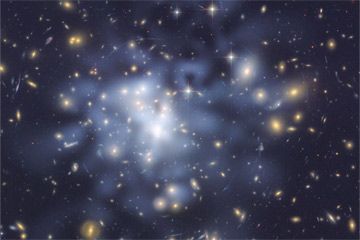Imagine you want to determine the mass of a house and its contents. You pick up the house and set it on a giant scale. Let's say, for argument's sake, you measure the mass to be 100,000 pounds (45,359 kilograms). Now imagine you want to see what each item in the house contributes to the total mass. You remove one item at a time and place it on the scale. You even eliminate all of the air to get a measure of its mass. Now let's say the mass of the individual objects, including the floor, walls and roof of the house, adds up to 5,000 pounds (2,268 kilograms). What would you think? How would you account for the discrepancy in masses? Would you conclude that there must be some unseen material in the house making the structure heavier?
For the last 40 years, this is exactly the dilemma astronomers have faced as they've tried to determine the building blocks of the universe. Before then, they thought the universe contained normal matter -- the stuff you can see. Scan across the cosmos, and this kind of stuff seems obvious. There are billions of galaxies, each filled with billions of stars. Around some of those stars, planets and their moons trace elliptical orbits. And in between those large, spherical bodies lie irregularly shaped objects, ranging in size from huge asteroids to rock-sized meteoroids to tiny particles no larger than a grain of dust. Astronomers classify all of this stuff as baryonic matter, and they (and we) know its most fundamental unit as the atom, which itself is composed of even smaller subatomic particles, such as protons, neutrons and electrons. (For simplicity's sake, we'll leave the leptons and quarks out of it.)
Advertisement
Starting in the 1970s, astronomers began collecting evidence that made them suspect there was more to the universe than meets the eye. One of the biggest clues came when scientists tried to determine the masses of galaxies. They did this by measuring the acceleration of clouds orbiting on the outer edges of a galaxy, which enabled them to calculate the mass required to cause that acceleration. What they found was surprising: The mass behind the orbital acceleration of a galaxy's clouds was five times larger than the mass of the stuff you could see -- stars and gas -- spread across the galaxy. They concluded that there must be some invisible material surrounding a galaxy and holding it together. They called this material dark matter, borrowing a term first used by Swiss astronomer Fritz Zwicky in the 1930s.
Twenty years later, scientists noticed that type Ia supernovae -- dying stars that all have the same intrinsic brightness -- were farther away from our galaxy than they should have been. To explain this observation, they suggested that the expansion of the universe is actually accelerating, or speeding up. This was perplexing, because the gravity inherent in dark matter should have been strong enough to prevent such an expansion. Was some other material, something with an antigravity effect, causing the rapid expansion of the universe? The astronomers believed so, and they called this material dark energy.
For a decade, cosmologists and theoretical physicists debated the existence of dark matter and dark energy. Then, in June 2001, NASA launched the Wilkinson Microwave Anisotropy Probe, or WMAP. The instruments on this craft took the most detailed picture ever of the cosmic microwave background -- the lingering radiation left over from the Big Bang. This enabled astronomers to measure, with great accuracy, the density and composition of the universe. Here's what WMAP determined: Baryonic matter makes up a paltry 4.6 percent of the universe. Dark matter accounts for just 23 percent. And dark energy makes up the rest -- a whopping 72 percent [source: NASA/WMAP]!
Of course, measuring the relative proportions of the universe's building blocks is just the beginning. Now scientists are hoping to identify likely candidates for dark matter. They regard brown dwarfs as one plausible candidate. These starlike objects aren't luminous, but their intense gravity, which affects nearby objects, provides clues about their existence and location. Supermassive black holes could also account for the dark matter in the universe. Astronomers speculate that these cosmic sinkholes may power distant quasars and may be more far more abundant than ever imagined. Finally, dark matter could consist of a type of particle not yet described. These tiny bits of matter could exist somewhere deep in an atom and may be identified in one of the world's super-colliders, such as the Large Hadron Collider.
Solving this mystery remains one of science's highest priorities. Until that solution comes, we must live with the humbling idea that the house we've been trying to weigh for years is heavier than we expected and, more troubling, beyond our understanding.
Advertisement


